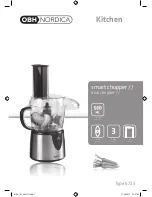
1-12
INTRODUCTION
ORBAN MODEL 8382
mask quantization noise. This is also true of any lossy data reduction applied in the
studio (such as hard disk digital delivery systems).
For MPEG Layer 2 encoding, we recommend 384 kB/second or higher.
Some links may use straightforward PCM (pulse-code modulation) without lossy
data reduction. If you connect to these through an AES3 digital interface, these can
be very transparent provided they do not truncate the digital words produced by
the devices driving their inputs. Because the 8382’s output is tightly band-limited to
15 kHz, it can be passed without additional overshoot by equally well by any link
with 32 kHz or higher sample frequency.
Currently available sample rate converters use phase-linear filters (which have con-
stant group delay at all frequencies). If they do not remove spectral energy from the
original signal, the sample rate conversion, whether upward or downward, will not
add overshoot to the signal. This is not true of systems that are not strictly band-
limited to 15 kHz, where downward sample rate conversion will remove spectral en-
ergy and will therefore introduce overshoot.
If the link does not have an AES3 input, you must drive its analog input from the
8382’s analog output. This is less desirable because the link’s analog input circuitry
may not meet all requirements for passing processed audio without overshoot.
NICAM
is a sort of hybrid between PCM and lossy data reduction systems. It uses
J.17 pre-emphasis and a block-companded floating-point representation of the sig-
nal.
Older technology converters (including some older NICAM encoders) may exhibit
quantization distortion unless they have been correctly dithered. Additionally, they
can exhibit rapid changes in group delay around cut-off because their analog filters
are ordinarily not group-delay equalized. The installing engineer should be aware of
all of these potential problems when designing a transmission system.
Any problems can be minimized by always driving a digital STL with the 8382’s AES3
digital output, which will provide the most accurate interface to the STL. The digital
input and output accommodate sample rates of 32 kHz, 44.1 kHz, 48 kHz, 88.2 kHz,
and 96 kHz.
Composite Baseband Microwave STLs
The composite baseband microwave STL carries the stereo baseband in the BTSC and
EIAJ systems, and therefore receives the output of a stereo encoder located at the
studio site. The composite STL receiver’s output is the stereo baseband signal, which
is applied directly to the wideband input of the TV broadcast transmitter’s exciter.
Thus, no stereo encoder is needed at the transmitter.
In general, a composite microwave STL provides good audio quality as long as there
is a line-of-sight transmission path from studio to transmitter of less than 10 miles
(16 km). If not, RF signal-to-noise ratio, multipath distortion, and diffraction effects
can cause serious quality problems. Where a composite STL is used, use the 8382’s
stereo encoder to drive the composite STL transmitter.
Summary of Contents for Optimod-TV 8382
Page 22: ......
Page 108: ......
Page 162: ......
Page 174: ......
Page 213: ...OPTIMOD TV DIGITAL TECHNICAL DATA 6 25...
Page 219: ...OPTIMOD TV DIGITAL TECHNICAL DATA 6 31 CPU Module...
Page 225: ...OPTIMOD TV DIGITAL TECHNICAL DATA 6 37 RS232 BOARD PARTS LOCATOR...
Page 227: ...OPTIMOD TV DIGITAL TECHNICAL DATA 6 39 POWER SUPPLY PARTS LOCATOR...
Page 229: ...OPTIMOD TV DIGITAL TECHNICAL DATA 6 41 8382 I O Board Parts Locator...
Page 234: ...6 46 TECHNICAL DATA ORBAN MODEL 8382 DSP BOARD PARTS LOCATOR DRAWING 32170 000 14...
Page 242: ...6 54 TECHNICAL DATA ORBAN MODEL 8382 DISPLAY BOARD PARTS LOCATOR...
Page 243: ...OPTIMOD TV DIGITAL TECHNICAL DATA 6 55 DISPLAY BOARD...
















































